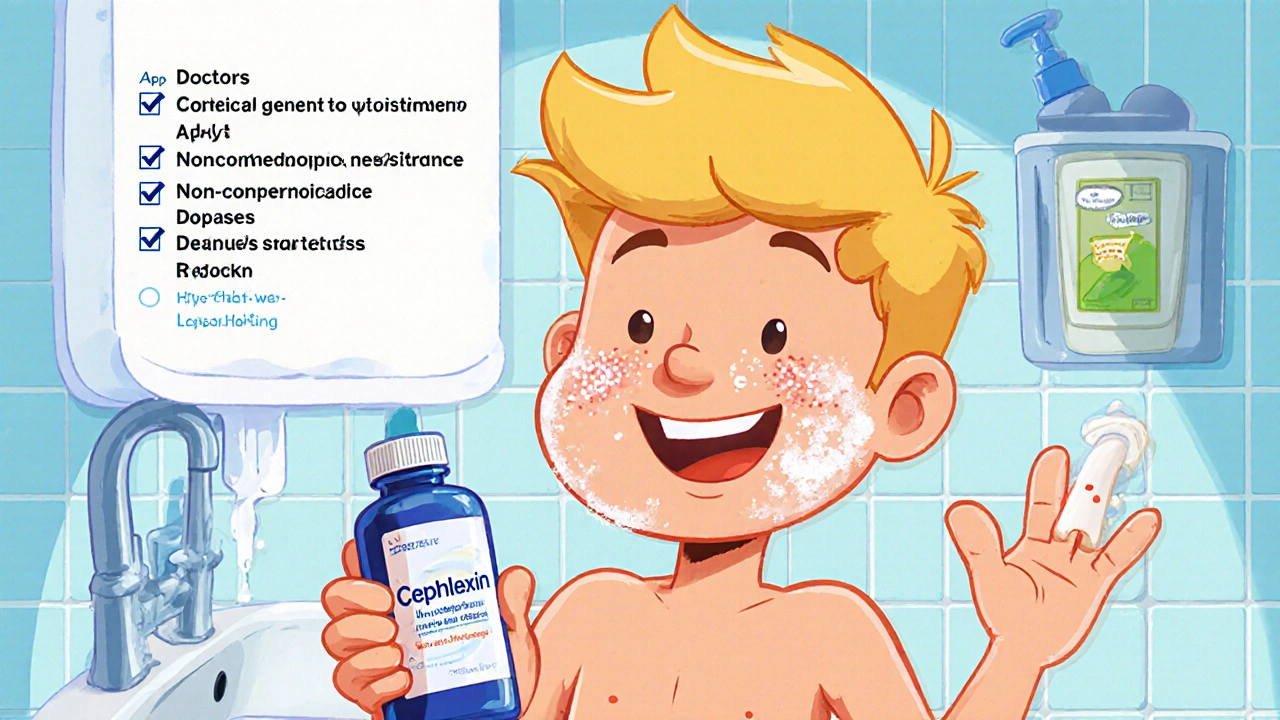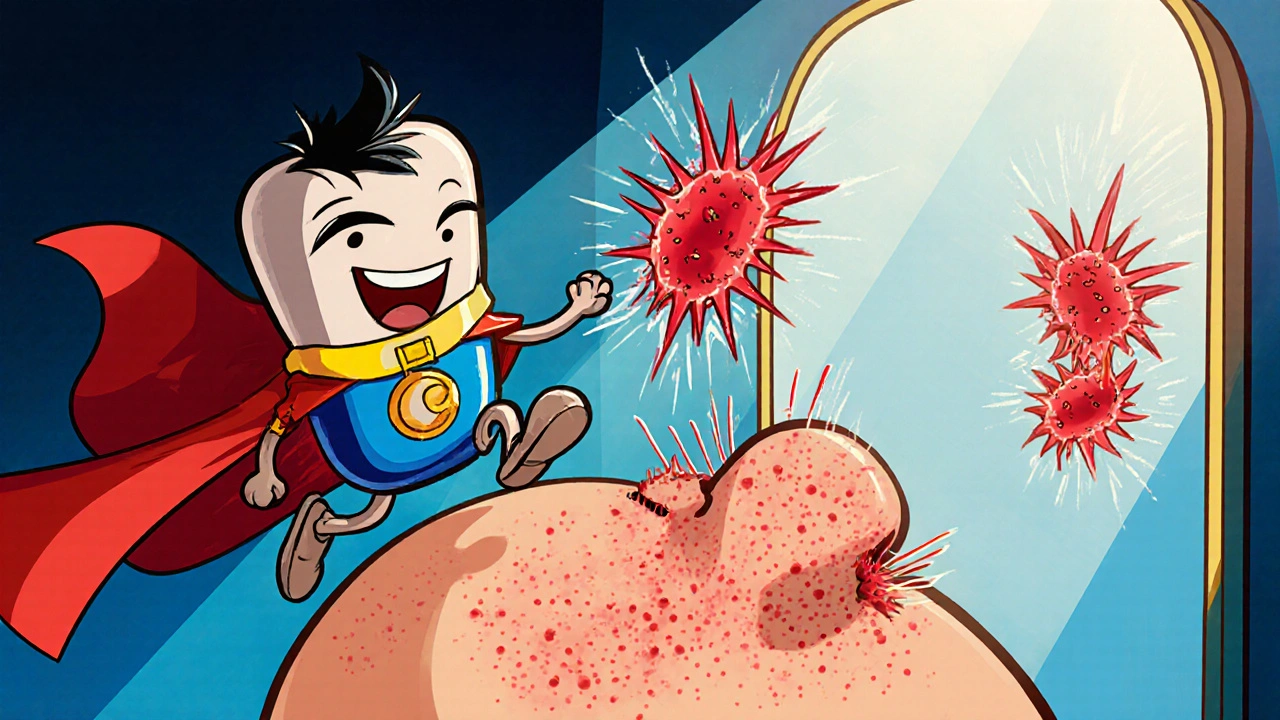Cephalexin Acne Dosage Calculator
Dosage Calculator
Calculate Cephalexin dosage for acne treatment based on patient weight.
Enter your weight and select age group to see calculated dosage.
When you hear the word Cephalexin is a first‑generation cephalosporin antibiotic that fights a broad range of bacterial infections, especially those caused by staphylococci and streptococci. But can this drug also clear up stubborn breakouts? Many people wonder if a medication usually prescribed for a sore throat or urinary tract infection could double as an acne solution.
How Cephalexin Works on Your Skin
Acne forms when pores become clogged with oil and dead skin cells, creating an environment where bacteria thrive. The main culprit is Cutibacterium acnes (formerly Propionibacterium acnes). Cephalexin targets the bacterial cell wall, preventing the bacteria from multiplying.
Unlike some acne drugs that also reduce oil production, Cephalexin’s job is purely antimicrobial. That means it can be a good option when you have a clear bacterial infection alongside acne, such as a secondary skin infection or folliculitis.
Is Cephalexin Effective for Acne?
Clinical evidence for Cephalexin specifically treating acne is limited. Dermatologists usually favor tetracycline‑class antibiotics (doxycycline, minocycline) because they also have anti‑inflammatory properties. However, real‑world experience shows Cephalexin can reduce acne lesions when the breakout is driven by a staph infection or when patients can’t tolerate tetracyclines.
So, the short answer: it may help, but it’s not the first‑line choice. If you’re already prescribed Cephalexin for another infection, you might notice your acne improving as a side benefit.
Typical Dosage for Acne‑Related Use
- Adults: 250mg to 500mg taken orally every 6hours (four times a day).
- Children (over 12kg): 25mg/kg per day divided into 4 doses.
- Course length: 4-6weeks for acne, but always follow your doctor’s guidance.
It’s crucial not to stop the medication early-even if your skin looks clearer-because premature cessation can encourage resistant bacteria.

Comparison with Other Common Acne Antibiotics
| Antibiotic | Typical Acne Dosage | Anti‑inflammatory Effect | Common Side Effects | Best For |
|---|---|---|---|---|
| Cephalexin | 250‑500mg q6h | Low | Diarrhea, rash, yeast infection | Acne with secondary bacterial infection |
| Doxycycline | 100mg once or twice daily | High | Sun sensitivity, stomach upset | Inflammatory acne, widespread lesions |
| Minocycline | 100mg once daily | High | Vertigo, hyperpigmentation | Moderate to severe acne, resistant cases |
| Tetracycline | 500mg twice daily | Medium | Nausea, photosensitivity | Mild‑to‑moderate acne, cost‑sensitive patients |
Potential Risks and What to Watch For
All antibiotics carry a risk of causing resistance. Overusing Cephalexin for acne could make Staphylococcus aureus or Cutibacterium acnes less susceptible, limiting future treatment options.
Side effects are generally mild but can be bothersome:
- Gastrointestinal upset - take the pill with food to lessen it.
- Yeast infections - especially in warm, moist areas.
- Allergic reactions - rash, itching, swelling; stop the drug and seek medical help immediately.
Pregnant or breastfeeding individuals should avoid Cephalexin unless explicitly approved by a healthcare professional.
When to Choose Cephalexin Over Other Options
- If you have a confirmed staph skin infection alongside acne.
- If you cannot tolerate tetracyclines due to allergy or severe sun sensitivity.
- If your doctor prescribes it for another condition and you notice an acne improvement.
- If you need a short‑term, high‑dose regimen to clear a localized outbreak.
In most routine acne cases, dermatologists will still start with a topical regimen (benzoyl peroxide, retinoids) before moving to oral antibiotics.

Integrating Cephalexin into a Broader Acne Routine
Combine the antibiotic with a gentle cleanser and a non‑comedogenic moisturizer. Adding Benzoyl peroxide in the morning helps kill surface bacteria and reduces the chance of resistance. At night, a topical Retinoid (adapalene or tretinoin) speeds up cell turnover.
Always schedule a follow‑up appointment after 4-6 weeks to assess progress and decide whether to continue, taper, or switch therapy.
Quick Checklist Before Starting Cephalexin
- Confirm you have a bacterial component (doctor’s diagnosis).
- Discuss any allergies, especially to penicillins or other cephalosporins.
- Review current medications for potential interactions.
- Plan for a 4‑week minimum course.
- Monitor for side effects and report them promptly.
Frequently Asked Questions
Can I use Cephalexin for mild acne without a bacterial infection?
It’s not recommended. Mild acne usually responds best to topical treatments. Oral antibiotics are reserved for moderate to severe cases or when there’s an obvious infection.
How long does it take to see results?
Most patients notice improvement within 2‑3 weeks, but the full effect may require 6‑8 weeks of consistent use.
Is Cephalexin safe for teenagers?
Yes, if the dosage is adjusted for weight. Teenagers over 12kg can take 25mg/kg per day, split into four doses. Always follow a physician’s prescription.
What should I do if I develop a rash while on Cephalexin?
Stop the medication and contact your doctor immediately. A rash can signal an allergic reaction, which may require an alternative treatment.
Can I combine Cephalexin with other acne meds?
Yes, pairing it with benzoyl peroxide and a retinoid is common practice. The topical agents tackle surface bacteria and clogged pores, while Cephalexin handles deeper infection.

8 Comments
Julia Grace
Cephalexin can actually help when you’ve got a bacterial flare‑up alongside your acne, but it’s not a magic bullet for every breakout. The drug targets the cell wall of Staph and Cutibacterium, so you’ll see improvement mainly if those bugs are driving the lesions. Keep in mind it lacks the anti‑inflammatory punch that tetracyclines have, so you might still need a topical to calm the redness. Stick to the doctor’s dosage – usually 250‑500 mg every six hours for a few weeks – and don’t stop early or you’ll invite resistance. Pair it with a gentle cleanser and benzoyl peroxide to cover both bases and you’ll give yourself the best shot at clearer skin.
Sadie Bell
Totally agree, it’s worth a try if you already have the prescription.
Noah Bentley
Let’s unpack the hype around using Cephalexin for acne with a healthy dose of sarcasm and grammatical precision. First off, antibiotics are not candy; they’re a serious medical intervention that should be reserved for documented bacterial infections. The literature shows only weak evidence that Cephalexin clears up non‑infectious acne, so you’re basically betting on a side effect. If your dermatologist prescribes a tetracycline, it’s because those drugs hit the inflammation axis that Cephalexin completely ignores. Sure, you might see a drop in pustules if there’s a hidden staph infection, but that’s a niche scenario. Taking a broad‑spectrum cephalosporin for weeks without a clear indication can breed resistant bacteria, a public‑health nightmare. Also, the side‑effect profile isn’t trivial – think diarrhea, yeast overgrowth, and possible allergic reactions. Pregnant or nursing patients should steer clear unless a doctor says otherwise. The dosing schedule (four times a day) is a compliance nightmare for most people, which can lead to sub‑therapeutic levels and further resistance. Remember, the FDA hasn’t approved Cephalexin for acne, so insurance may not even cover it. If you’re already on Cephalexin for a throat infection, you might notice a skin glow‑up, but that’s an incidental benefit, not a primary treatment plan. Bottom line: don’t jump on the Cephalexin train for acne unless you have a confirmed secondary infection and your doctor signs off. Otherwise, stick with proven combos like doxycycline plus topical retinoids. And please, finish the full course if you do start it – stopping early is the fastest way to create a superbug.
Kathryn Jabek
While the preceding commentary delights in sardonic dismissal, a measured appraisal reveals that Cephalexin occupies a circumscribed niche in dermatologic therapeutics. Its bacteriostatic vigor against Staphylococcus aureus aligns with cases wherein a confluent folliculitis coexists with acne vulgaris. Yet, the absence of intrinsic anti‑inflammatory capacity relegates it to adjunct status rather than frontline monotherapy. The practitioner must therefore weigh the risk of antimicrobial resistance against the prospective gain of lesion attenuation. In summation, deployment of Cephalexin should be judicious, predicated upon microbiological confirmation rather than anecdotal conjecture.
Ogah John
Thinking about throwing Cephalexin into your acne arsenal? Only do it if a doctor has diagnosed a bacterial component, otherwise you’re just feeding the resistance machine. It’s great for tackling a stubborn staph breakout, but it won’t calm oily skin or hormonal flare‑ups. Pair it with benzoyl peroxide and a retinoid for a balanced attack – one handles surface bugs, the other clears the pores. And remember, finish the whole course; stopping early wastes the drug and your skin.
Kelvin Murigi
I’ve seen patients who couldn’t tolerate doxycycline due to severe sun sensitivity, and Cephalexin turned out to be a solid fallback. Make sure you take it with food to minimize GI upset, and monitor for any yeast overgrowth, especially in humid areas. If you notice a rash, pause and call your dermatologist – it could be an allergic reaction. Combining it with topical benzoyl peroxide reduces the chance of resistance and hits the bacteria on two fronts, which is a smart strategy for stubborn lesions.
ahmad matt
Honestly, prescribing a high‑dose cephalosporin for a cosmetic issue is a classic case of overtreatment. Most acne isn’t driven by the kind of bacteria Cephalexin targets, so you’re just adding unnecessary side‑effects. Plus, the four‑times‑daily schedule is a compliance nightmare that invites sub‑therapeutic dosing and resistance. If you’re looking for a quick fix, stick with proven topical regimes and reserve oral antibiotics for truly infected cases.
kristine ayroso
Yo, let’s cut the BS – if you’ve got a normal teen breakout, you don’t need a IV‑level antibiotic. Those pills are for serious infections, not for popping pimples. Save your gut and the planet’s microbes; grab a benzoyl wash and a retinoid cream instead. And if a doc pushes Cephalexin on you without a legit infection, call them out – we’re not guinea pigs.